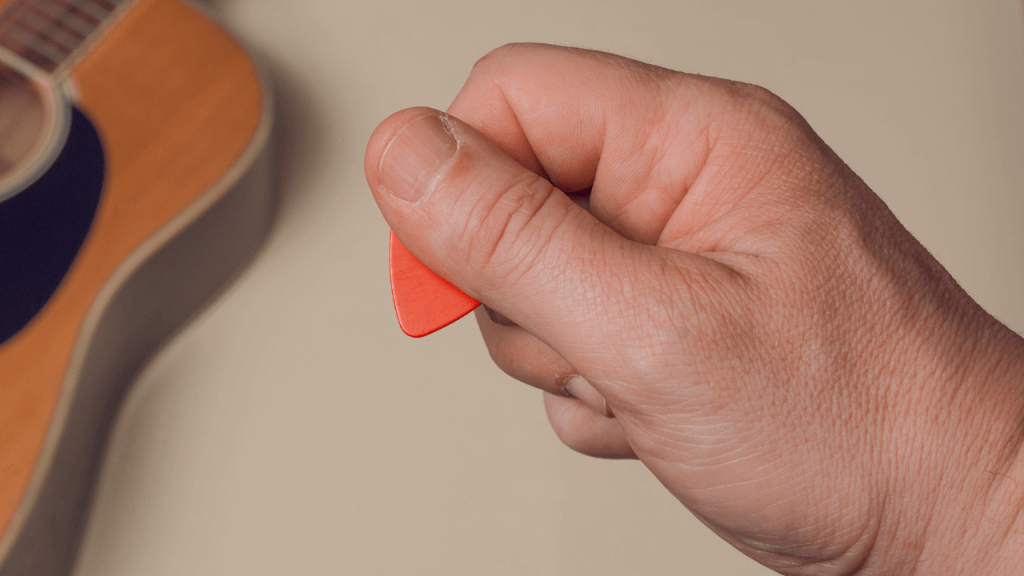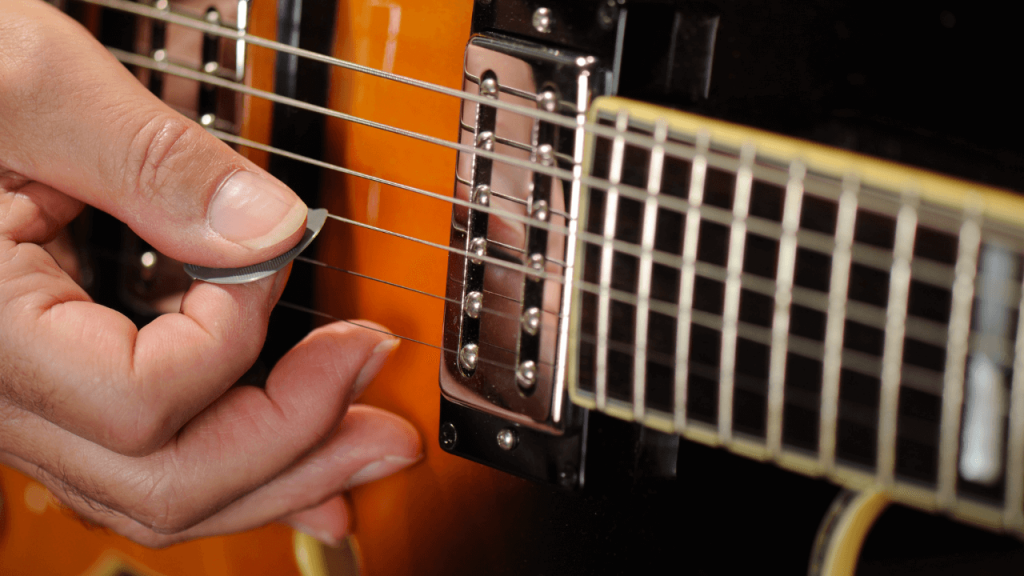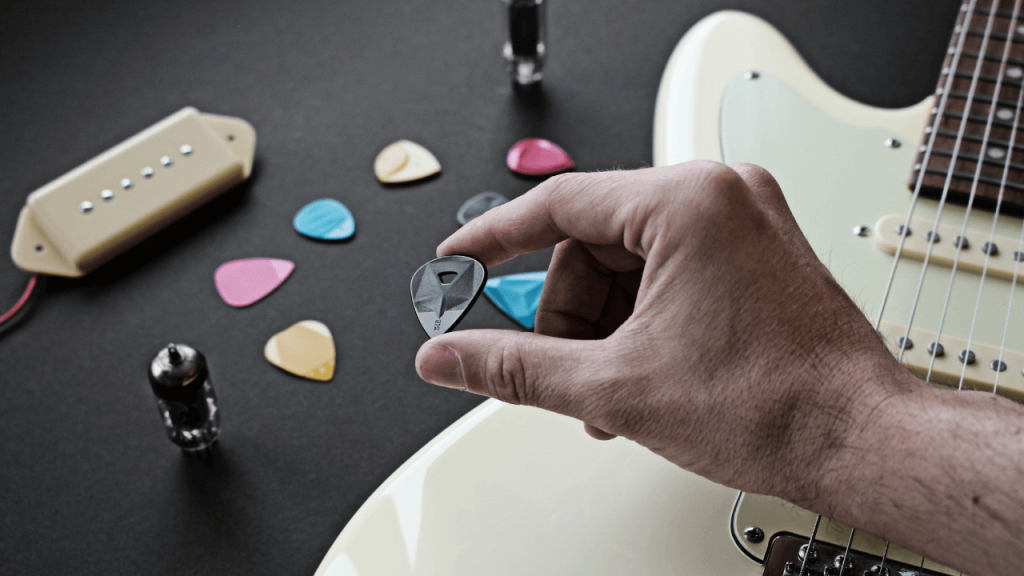Welcome to our expert-curated, beginner-friendly guide on how to hold a guitar pick correctly! If you’re just starting out on your guitar journey, one of the fundamental skills you’ll need to master is how to hold a guitar pick.
Our experienced guitarist and instructor, Thoralf, brings you proven techniques for optimal playing performance.
Proper pick placement and grip play a crucial role in producing clean, consistent, and confident guitar sounds.
In this article, we’ll walk you through step-by-step instructions on how to hold a guitar pick correctly. So, grab your guitar and pick and let’s dive in!
What is a guitar pick and why do guitar players need one?
Before we dive into the specifics of how to hold a guitar pick correctly, let’s take a moment to understand the basics. A guitar pick, also known as a plectrum, is a small tool made of various materials such as plastic, nylon, or metal.
It is used to strike or pluck the strings of a guitar, producing a clear and defined sound.
The shape of a guitar pick is typically triangular, with rounded or pointed corners. The size and thickness of picks can vary, catering to different playing styles and personal preferences.
Thinner picks generally provide more flexibility and are ideal for strumming and rhythm playing, while thicker picks offer more precision and control for intricate picking and soloing.
The primary purpose of a guitar pick is to enhance the sound produced by the strings. By using a pick, you can achieve a consistent attack and tone, allowing for greater articulation and dynamics.
It also helps protect your fingers from excessive strain and allows for faster and more efficient playing.
Now that we have a basic understanding of what a guitar pick is and its purpose, let’s move on to the next section and explore how to hold it correctly for optimal playing performance.
How to Hold a Guitar Pick Correctly – Step-by-step
To hold a guitar pick correctly, proper placement is crucial. Follow these steps to ensure you position the pick optimally for efficient and accurate playing:
- Begin by placing the pick between your thumb and index finger. Hold the pick so that it is parallel to the strings, with the pointed end facing the guitar’s body.
- Extend your thumb slightly and place the pick’s tip just beyond the end of your thumb. This placement allows for better control and precision when striking the strings.

- Ensure that you’re holding the pick firmly but not too tightly. A relaxed grip will prevent unnecessary tension in your hand and allow for smoother movements.
- Position your hand comfortably, with your wrist relaxed and in a natural position. Avoid excessive bending or strain in your wrist, as it can lead to fatigue and discomfort during prolonged playing sessions.
- As you hold the pick, make sure that only a small portion of it extends beyond your thumb. This will provide the necessary surface area for striking the strings while maintaining control.
Here is a video to give you a better idea of what we just talked about:
Remember, finding the right pick placement may require some experimentation. Everyone’s hand shape and size differ, so adjust the placement until you find a comfortable and effective position that works best for you.
With practice, you will develop muscle memory and a consistent pick placement technique.
In the next section, we’ll discuss different grip techniques that you can try to further enhance your guitar playing experience.
Grip Techniques to hold a guitar pick
When it comes to holding a guitar pick, there are several grip techniques you can explore. Each technique offers its own advantages, and finding the one that feels most comfortable and natural to you is key.
Let’s take a look at two commonly used grip styles:
The Standard Grip
The standard grip is widely used and suitable for various playing styles. Follow these steps to achieve the standard grip:
- Hold the pick between your thumb and index finger.
- Rest your thumb on top of the pick, applying gentle pressure to keep it in place.
- Your index finger should wrap around the pick’s side, providing stability and control.
- Find a balance between a firm grip and allowing the pick to move freely. Avoid gripping it too tightly, as it can hinder your flexibility and strumming motion.
The standard grip offers versatility and is a great starting point for beginners. It allows for ease in switching between strumming and picking techniques, making it suitable for various musical genres.
The Three-Finger Grip
The three-finger grip offers additional stability, which can be advantageous for certain playing styles that require speed and precision. Follow these steps to achieve the three-finger grip:
- Hold the pick between your thumb, index, and middle fingers.
- Place your thumb on top of the pick, just as you would in the standard grip.
- Your index and middle fingers should curl around the sides of the pick, providing additional support.
- Adjust the position and angle of your fingers until you find a comfortable and secure grip.
The three-finger grip offers a stronger hold on the pick, which can be beneficial for techniques like alternate picking or fast, intricate passages. It may take some time to get accustomed to this grip, but it can provide added control once you become comfortable with it.
Remember, the grip technique you choose should ultimately feel natural and enable you to play with ease. Don’t be afraid to experiment with different grip styles and make adjustments based on your hand size and playing preferences.
In the next section, we’ll provide some valuable tips specifically for beginners on how to hold a guitar pick correctly.

Finding Your Comfort Zone
When it comes to holding a guitar pick, finding your comfort zone is essential. Everyone’s hands are unique, and what works for one guitarist may not work for another.
Experimenting with different pick placements, grip techniques, and hand positions will help you discover the most comfortable and effective way for you to hold a pick.
Here are some tips to guide you in finding your comfort zone:
Relaxation is key: When holding a guitar pick, aim for a relaxed grip. Avoid gripping the pick too tightly, as it can lead to tension and fatigue in your hand. Find a balance between maintaining a secure grip and allowing for flexibility and freedom of movement.
Hand and wrist positioning: Position your hand and wrist in a way that feels natural and comfortable for you. Avoid excessive bending or strain in your wrist. Keep it in a neutral position, allowing for fluid movement and reducing the risk of strain or injury.
Try different angles: Experiment with different angles at which you hold the pick. Some guitarists prefer a flatter angle, while others tilt it slightly towards the strings. Find the angle that allows you to strike the strings cleanly and comfortably.
Adjust pick thickness and material: Picks come in various thicknesses and materials, each offering a different feel and sound. Try picks of different gauges and materials such as plastic, nylon, or metal to find the one that suits your playing style and preference. Thinner picks generally provide more flexibility, while thicker ones offer more control and precision.
Take breaks and listen to your body: As you practice and play, pay attention to any discomfort or tension in your hand. Take regular breaks to rest and stretch your hand and fingers. It’s important to listen to your body and make adjustments if something doesn’t feel right. Proper technique and comfort go hand in hand.
Remember, the goal is to find a pick-holding technique that allows you to play comfortably and with control. It may take some time and experimentation, but once you find your comfort zone, it will greatly enhance your playing experience.
In the next section, we’ll discuss some valuable tips for beginners on choosing the best guitar picks to complement your pick-holding technique.
Tips for Beginners
If you’re a beginner learning how to hold a guitar pick correctly, here are some valuable tips to help you along the way:
Start with a thin or medium gauge pick: As a beginner, it’s generally recommended to start with a thinner or medium gauge pick. Thinner picks offer more flexibility, making it easier for you to strike the strings smoothly.
They are also less likely to get caught in the strings. As you gain more experience and control, you can experiment with different pick gauges to find the one that suits your playing style.
Experiment with different pick materials: Guitar picks come in various materials, each offering a unique feel and sound. Popular materials include plastic, nylon, and Tortex.
Try out picks made from different materials to see which one you prefer. Each material can produce different tones and textures, allowing you to explore a range of sounds on your guitar.
Hold the pick firmly but not too tight: It’s important to find the right balance in your grip. Holding the pick too tightly can lead to tension and restrict your movement. On the other hand, holding it too loosely can cause it to slip or feel unstable.
Aim for a firm grip that allows you to control the pick while maintaining a relaxed hand and wrist.
Practice different strumming and picking techniques: Once you have a basic understanding of how to hold a pick correctly, dedicate time to practice various strumming and picking techniques.
This will help you develop dexterity and control. Start with simple exercises and gradually increase the complexity as you progress. Consistent practice will improve your muscle memory and overall technique.
Seek guidance from a qualified instructor: If possible, consider taking lessons from a qualified guitar instructor. They can provide personalized guidance, correct any improper techniques, and offer valuable tips and exercises to improve your pick holding skills.
An instructor will ensure that you build a strong foundation right from the beginning.
By implementing these tips and dedicating regular practice, you’ll gradually develop proficiency in holding a guitar pick correctly. Remember, patience and persistence are key in your journey to becoming a skilled guitarist.
In the next section, let’s explore some of the best guitar picks for beginners, considering factors such as durability, versatility, and affordability.

Best Guitar Picks for Beginners
As a beginner, selecting the right guitar pick can greatly impact your playing experience. Here are some excellent picks that are known for their durability, versatility, and affordability:
- Fender Medium Celluloid Picks: Fender is a renowned name in the guitar world, and their medium celluloid picks are widely popular among guitarists.
These picks offer a balanced feel and excellent grip. They are available in various colors and designs, allowing you to express your personal style while honing your skills.
- Dunlop Tortex Standard Picks: Dunlop Tortex picks are highly regarded for their durability and consistency. They are made from high-quality material that provides a comfortable grip and ensures a consistent tone.
Tortex picks come in a range of gauges, catering to different playing preferences. Beginners often find the Tortex Standard series to be versatile and reliable.
- Ernie Ball Everlast Picks: Ernie Ball Everlast picks are crafted from high-quality Delrin material. They offer a smooth playing experience and provide a comfortable grip for extended practice sessions.
These picks are known for their durability and are suitable for various playing styles. Ernie Ball Everlast picks are available in different thicknesses to accommodate individual preferences.
- D’Addario Assorted Pearl Celluloid Picks: D’Addario is a trusted brand in the guitar community, and their assorted pearl celluloid picks are an excellent choice for beginners. These picks offer a smooth surface, allowing for easy glide across the strings.
They come in a variety of thicknesses, giving you the opportunity to experiment with different styles and sounds.
- Jim Dunlop Nylon Standard Picks: Jim Dunlop nylon standard picks are another popular option for beginners. These picks are affordable, versatile, and provide a comfortable grip. They offer a balanced tone and are suitable for a wide range of musical genres.
Remember, the best pick for you ultimately depends on your personal preference and playing style. As a beginner, it’s recommended to try out a few different picks to see which one feels most comfortable and suits your needs.
Congratulations! You’ve learned the essential techniques and tips on how to hold a guitar pick correctly. Remember, practice is key to refining your technique and developing your unique playing style.
Experiment with different picks, grip styles, and hand positions to find what works best for you. With time and dedication, you’ll be strumming your favorite tunes with confidence and precision.
So, grab your guitar, pick up that pick, and let your musical journey begin!

